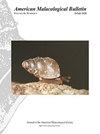A Reproductive Histological Analysis of Rangia cuneata (Venerida: Mactridae): Effects of Abiotic Factors
IF 0.4
4区 生物学
Q4 MARINE & FRESHWATER BIOLOGY
引用次数: 1
Abstract
Understanding the relative times of gametogenesis and spawning of gametes in bivalves provides crucial insight on how a species may be influenced by environmental factors, in addition to the potential impacts a species of bivalve has on the ecosystem as a whole. The focus of this study was on gametogenesis and times of spawning in Rangia cuneata (G. B. Sowerby I, 1831), an infaunal estuarine bivalve inhabiting Johnson Bayou, Pass Christian, MS, and how salinity gradients may influence spawning. Specimens were collected monthly in 2016 from three sites along an established salinity gradient (0–16 ppt) within Johnson Bayou. Using standard histological methods and a quantitative method to estimate both the abundance of gametes and spawning times, this study showed that over the course of one year the rate of gametogenesis and times of spawning differed among sites. Clams of both sexes in the site closest to the opening of the bayou (lower site) produced gametes and spawned earlier (June) than those collected from the middle and upper sites (October–November). Interestingly, two separate spawning events are likely to have occurred by clams collected from the lower and middle sites. There was a positive correlation between increasing water temperature and mean percent gonadal tissue in all sites with a significant correlation at the middle and upper sites. In contrast, no correlation was found between salinity levels and mean percent gonadal tissue in clams from the lower site, while a weak positive but non-significant correlation was seen with clams from the middle and upper sites. There was a weak negative correlation between salinity levels and mean percentage of ripe gametes from the lower and middle sites, but a weak positive correlation from the upper site. The results indicate that the same species can vary the amount of gametes and spawning times in the same estuarine system, presumably due to the effects of abiotic factors, namely water temperature and salinity.楔蛙生殖组织学分析:非生物因素的影响
了解双壳类动物配子发生和配子产卵的相对时间,除了了解双壳类动物对整个生态系统的潜在影响外,还有助于了解一个物种如何受到环境因素的影响。本文研究了生活在美国密西西比州约翰逊湾(Johnson Bayou, Pass Christian, MS)的一种河口双壳类水生水生水生水生动物(Rangia cuneata, g.b. Sowerby I, 1831)的配子体发育和产卵时间,以及盐度梯度对产卵的影响。2016年,在约翰逊河口沿既定盐度梯度(0-16 ppt)的三个地点每月采集标本。利用标准的组织学方法和定量方法来估计配子的丰度和产卵时间,本研究表明,在一年的过程中,不同地点的配子发生率和产卵时间不同。在最靠近河口口的地点(较低的地点)采集的雌雄蛤蜊产生配子,比在中上游地点(10 - 11月)采集的蛤蜊更早(6月)产卵。有趣的是,从较低和中间地点收集的蛤蜊可能发生了两次单独的产卵事件。水温升高与平均性腺组织百分率呈显著正相关,中上游显著相关。相比之下,盐度水平与下部蛤蜊的平均性腺组织百分比之间没有相关性,而与中部和上部蛤蜊的性腺组织百分比呈弱正相关,但不显著。盐度水平与下部和中部的平均成熟配子百分比呈弱负相关,而上部的则呈弱正相关。结果表明,同一物种在同一河口系统中可以改变配子数量和产卵次数,这可能是由于水温和盐度等非生物因素的影响。
本文章由计算机程序翻译,如有差异,请以英文原文为准。
求助全文
约1分钟内获得全文
求助全文
来源期刊
CiteScore
1.00
自引率
40.00%
发文量
1
审稿时长
>12 weeks
期刊介绍:
The American Malacological Bulletin serves as an outlet for reporting notable contributions in malacological research. Manuscripts concerning any aspect of original, unpublished research,important short reports, and detailed reviews dealing with molluscs will be considered for publication. Recent issues have included AMS symposia, independent papers, research notes,and book reviews. All published research articles in this journal have undergone rigorous peer review, based on initial editor screening and anonymous reviewing by independent expertreferees. AMS symposium papers have undergone peer review by symposium organizer, symposium participants, and independent referees.

 求助内容:
求助内容: 应助结果提醒方式:
应助结果提醒方式:


